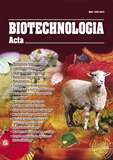ISSN 2410-7751 (Print)
ISSN 2410-776X (Online)

Biotechnologia Acta Т. 18, No. 2, 2025
P. 79-81 , Bibliography 6 , Engl.
UDC 577.112+616.15+616-092.9+663.85
doi: https://doi.org/10.15407/biotech18.02.079
BLOOD METALLOPROTEINS IN RATS UNDER CONDITIONS OF ENERGY DRINK CONSUMPTION
KH.Y. Partsei, M.B. Artysh, Н.M. Ersteniuk, H.V. Tokaryk, T.P. Maksymchuk
Ivano-Frankivsk National Medical University, Ukraine
Aim. The study putposd to evaluate the effect of energy drinks on the level of Cu, Fe, ceruloplasmin, and transferrin activity in the blood of rats.
Materials and methods. The study was conducted on white male Wistar rats divided into two groups: control and experimental. The experimental group received the energy drink Burn for 30 days. Blood samples were taken under anesthesia by decapitation on the 1st day after the drink was discontinued. The content of Cu and Fe was determined by atomic absorption spectrophotometry. Ceruloplasmin activity and transferrin saturation were studied by the method of Babenko G.O.
Results. Against the background of energy drink consumption in the experimental group, a decrease in the level of Cu by 43% and Fe by 67% was observed compared to the control. Transferrin saturation decreased by 42% and ceruloplasmin activity by 40%. The data obtained indicate that the consumption of an energy drink causes complex changes in the metabolism of Cu and Fe, which is reflected in a decrease in the level of these trace elements in the blood and the activity of metalloenzymes, in particular ceruloplasmin and transferrin, which can lead to the development of oxidative stress and impaired functioning of both individual organs and the body as a whole.
Conclusions. The results obtained indicate the development of dysmicroelementosis in the context of energy drink consumption, which can have adverse effects on the functioning of red blood cells, body systems, and tissues, an increase in the level of endogenous intoxication, and impaired tissue respiration.
Keywords: energy drink, rats, blood, Cu, Fe, сeruloplasmin, transferrin saturation.
© Palladin Institute of Biochemistry of the National Academy of Sciences of Ukraine, 2025
References
1. Guranych, S. P., Voronych-Semchenko, N. M., Guranych, T. V. (2017). Prooxidant-antioxidant
status of dental pulp and oral mucosa of rats with experimental iodine deficiency and insulin
resistance. Ukr. J. Medic., Boil. Ta Sport., 2(4), 16–20. (In Ukrainian).
2. Gkouvatsos, K., Papanikolaou G, Pantopoulos K. (2012). Regulation of iron transport and the role of
transferrin. Biochim. Biophys. Acta., 1820(3), 188–202. https://doi.org//10.1016/j.bbagen.2011.10.013.
3. Khan, F., Ahmad, N., Ahmed, S. (2021). Role of ceruloplasmin in oxidative stress and energy drinkinduced
toxicity. Oxid Med. Cell Longev., 6634792. https://doi.org//10.1155/20/663479
4. Lewandowski, Ł., Kepinska, M., Milnerowicz, H. (2018). Inhibition of copper-zinc superoxide
dismutase activity by selected environmental xenobiotics. Environmental Toxicology and
Pharmacology. Elsevier BV., 58, 105–13. URL: http://dx.doi.org/10.1016/j.etap.2017.12.022.
5. Maury, P. K., Kumar, P., Chandra, P. (2015). Biomarkers of oxidative stress in erythrocytes as a
function of human age. World Journal of Methodology. Baishideng Publishing Group Inc., 5(4), 216.
URL: http://dx.doi.org/10.5662/wjm.v5.i4.216.
6. Shkurashivska, S., Ersteniuk, H. (2019). The effect of adrenaline on the mineral and trace element
status in rats. Open Life Sciences. Walter de Gruyter GmbH., 14, 158–64. URL: http://dx.doi.
org/10.1515/biol-2019-0018.

